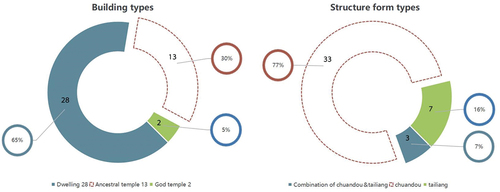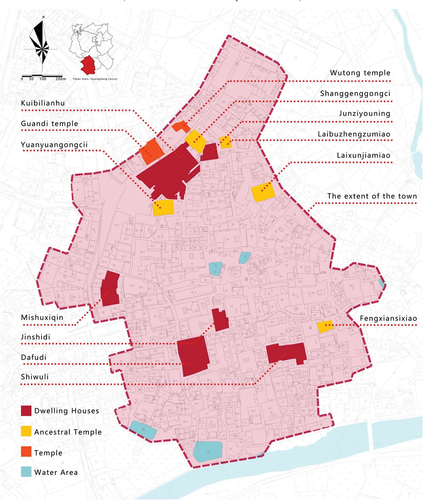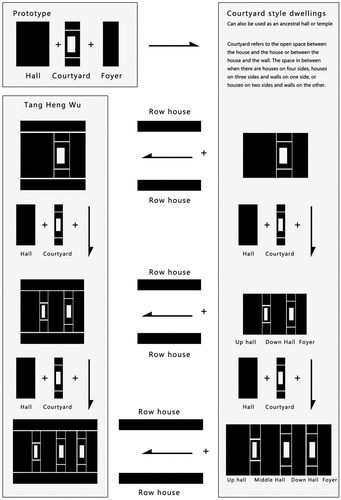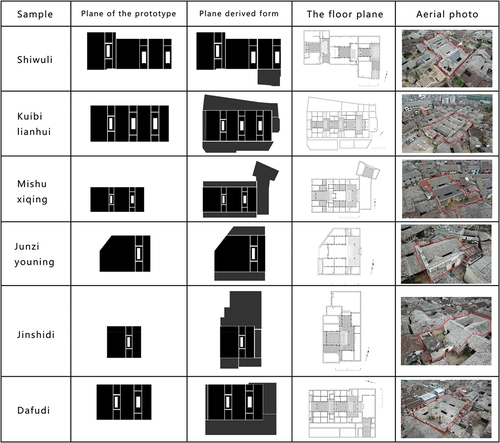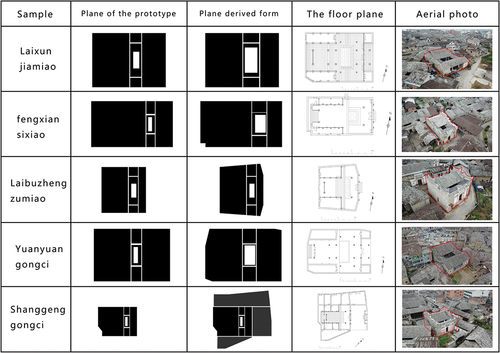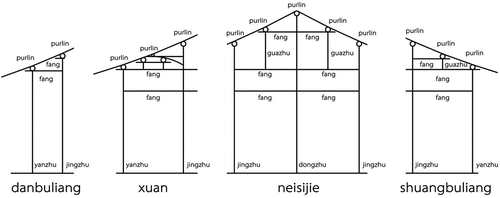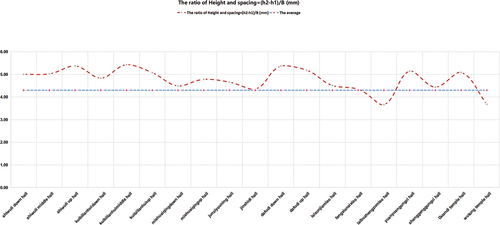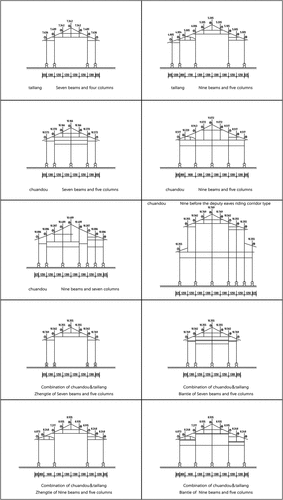ABSTRACT
Yiqian town is a famous historical and cultural town in China, with rich heritage of traditional architecture and diversified architectural forms, which shows the great achievements of Gan style architecture in technology and art. Based on the field survey and mapping of traditional buildings in Yiqian, this paper sorts out the performance of plane shape and structure characteristics in different building types, and analyzed the correlation of the above three. Finally, Abaqus software was used for mechanical analysis and Ecotect software was used for light and wind analysis. It is concluded that in Yiqian, the plane mode is highly applicable, the wooden frame processing technology is flexible, and the architectural form is suitable to the climate environment, which reveals the wisdom of the ancient craftsmen in building construction.
Graphical abstract

1. Introduction
Yiqian town is located in the border area of Jiangxi and Fujian province in China. There are a large number of well-preserved and large-scale Gan (Abbreviation of Jiangxi Province)-style traditional buildings. Yiqian have been successively rated as national historical and cultural town and national characteristic town. Under the influence of unique history, culture, people system and other factors, the traditional buildings in Yiqian have formed a variety of architectural branches, which are rich in architectural types, diverse in plane forms and obvious in structural characteristics, showing the complexity, diversity and integration of Yiqian culture. In view of the universality and diversity of the traditional architecture, timber frame of buildings often preserves more original characteristics, and directly reflects the inheritance relationship of the timber frame of the traditional buildings, which makes it of high research value.
This article uses some Chinese pinyin instead of English phrases in order to follow the original meaning of the words. A pinyin English glossary is provided here for reference.
Timber frame structure refers to the main structural part of the wooden frame in the traditional buildings, that is, the load-bearing part of the wooden frame, which is composed of columns beams, purlins and rafters. Timber frame structure is an important determinant of the scale and appearance of wooden buildings. From the book kaogongji, we can know that the division of carpentry in the Zhou Dynasty has been very fine, and the division of labor in the later generations is different. The title of carpentry work is originally derived from Yinzaofashi, a great work of 36 volumes, whose contents are specifically divided into four parts: frame system, work limit, material example and drawing. Each part is divided into 13 chapters. In addition, many practices recorded in Yuanye (Ji and Ni Citation2017) were also reflected in the Yiqian area.
This paper mainly discusses the timber frame structure of traditional architecture, that is, column, beam, purlin and other components of traditional buildings.
Over the past few decades, many studies have evaluated traditional architecture in Yiqian and focused on relevant architectural features. Tang Yao and Qing Cai classified and summarized traditional architecture, such as settlements, dwellings, ancestral temples and god temples, in their book Ancient Buildings of Jiangxi (Yao and Cai Citation2016), providing directional guidance for the study of traditional architecture types in Jiangxi. Hao Huang did a lot of research on the traditional dwellings and ancestral temples in Jiangxi in his book Jiangxi Dwellings (Huang Citation2008). It mainly discusses architectural culture and decoration of traditional buildings. In addition, Xuejian Xiao did some research related to architectural decoration in Yiqian town in his paper Cultural Exploration of Carved Decorations in Ancient Buildings of Ming and Qing Dynasties in Yiqian (Li and Xiao Citation2008). However, further targeted research on buildings itself has yet to be carried out.
In order to fill this gap, this paper summarizes the characteristics of building types, building plan types, beam forms and characteristics in Yiqian. Revealing the relationship between the above three, we also carry out simulation analysis on each building type by using Abaqus and Ecotect software, providing optical, wind and mechanical basis for the above conjecture, and providing a basis for further research.
2. Background
2.1. Building types
The traditional buildings in Yiqian town can be divided into residential buildings, ancestral temple and god temple. After entering the Qing Dynasty, Yiqian has become a traditional settlement with multiple families living together, with Lai’s being the largest and Bai’s the second. The residence of each family in the town is relatively concentrated, forming an obvious family area. Among them, the Lai family mainly lives in the eastern part of the town, the northern half of which is called up Lai, and the southern half of which is called down Lai. Bai’s family mainly lives in the west of the town street west. The rest of the smaller families are scattered around. Lai and Bai two big families have been multiplying for a long time, the distribution of residences and ancestral temples is very dense. The size of the Bai’s clan is smaller than that of Lai’s clan, and the number of ancestral temple was also less, with only one ancestral temple in the east of town. It was built in 1851 in the Qing Dynasty.
There are two god temples in the town, Guandi temple and Wutong temple. The Guandi temple is located in the south of the town. Guandi temple is an important part of Chinese traditional culture. Guandi is closely related to people’s life and is as famous as Confucius, the sage of civilization. Guandi is called as the Sage of Guan di.
Wutong temple is located in the north section of the town. Wutong is a god in charge of livestock in southern China. Its origin is not later than the Tang Dynasty, and its sources are varied and complex. It is widely accepted in temple sacrificial service in the form of idols.
2.2. Dwelling forms
The traditional dwellings in Yiqian town are mainly of the Gan-style traditional courtyard dwellings, and there are also a few of the tanghengwu style. There are some similarities between courtyard style layout and tanghengwu style layout, but there are great differences between courtyard layout and plane organization.
Traditional courtyard dwellings are usually small in scale, with regular rectangular plane, surrounded by blue stone walls, compact and delicate internal space. The courtyard is often taken as the layout center, and each complete courtyard forms a residential unit with hall as a group. The basic residential combination is a three-room wide entrance, namely the central hall facing the courtyard and wing room facing the courtyard. The central hall facing the courtyard is the daily living space in dwellings, and also serves as the dining room and ancestor worship. It can be said that it is the most important space in the dwellings.
Dwellings of tanghengwu style are usually bigger than the courtyard style dwellings in the scale. Tanghengwu often through the horizontal or vertical to set additional courtyards to extend its hall, the row house on both sides of the house is its typical characteristics, the main house is usually connected to the row house by a wing porch, blue brick, wood, rammed earth, bamboo and stone are often used to build terraced houses, and the shape is often irregular.
2.3. Timber beam frame structure
There are three types of beam frame structure in Yiqian: chuandou, tailiang, combination of chuandou and tailiang.
The main characteristic of the chuandou structure is the high integrity of the whole structure. A row of columns are set up along the depth of the house according to the number of purlins. Each column supports a purlin, and the purlin carries the roof load directly. Each row of purlins is threaded horizontally through the column body to form a frame. The advantage of chuandou is easy of application. The force of each component is also more uniform. The disadvantage is about the column, the arrangement is too close, only can be used when the indoor space scale is not big. These make chuandou become the most commonly used frame of dwellings and ancestral temples. Among 28 dwellings in Yiqian, 23 of them are chuandou. Among 13 ancestral temples, 10 of them are chuandou ().
Table 1. Traditional building list in Yiqian town.
The characteristics of tailiang is on the top of the column. Several layers of beams are arranged along the depth of the house. The beams are shortened layer by layer and short columns or wooden blocks are padded between layers. The top beam in the middle of a small column or triangular support, forming a triangular roof frame. Tailiang structure can use the beam with bigger span, reduce the number of column, obtain bigger inner space. So it is suitable for palaces and temples, both two god temples in Yiqian use tailiang, and only one dwelling uses tailiang due to the need for bigger inner space. However, Tailiang needs large amount of wood which makes it not as adaptable as chuandou ().
Combination of chuandou and tailiang means zhengtie uses tailiang and biantie uses chuandou. Its advantage is not only to obtain a larger space but also to overcome the characteristics of weak adaptability. The disadvantage is that the counterpoint is more complex and has higher requirements for construction technology. It is often used in ancestral temples and dwellings, among 13 ancestral temples, 3 for this type. Among 28 dwellings, 4 for this type ().
2.4. Sample selection
There are 43 representative traditional wooden frame buildings in Yiqian town.
Twenty-eight of them are dwellings and account for 65%, 13 for ancestral temples and account for 30%, 2 for temples and account for 5% ().
33 among them are chuandou type, accounting for 77%, 3 are tailiang type, accounting for 7%, 7 are Combination of chuandou and tailiang type, accounting for 16% ().
This paper intends to take 13 of the most representative traditional buildings(). (Shiwuli, Kuibilianhui, Laixunjiamiao, Mishuxiqing, Fengxiansixiao, Junziyouning, Yizhengfuju, Laibuzhengzumiao, Jinshidi, Dafudi, GuanDi temple, Wutong temple, Shanggenggongci) as the representative to conduct research ().
The reasons for sample selection are as follows:
The samples were built around the same time or concentrated into a piece of distribution. As a result, its architectural features often show a certain correlation ().
For each building type, building plan type and beams form, there are at least one sample being selected in the study. All the buildings being selected are typical traditional buildings with good preservation quality and higher protection level ().
Table 2. Example table of typical timber frames.
In addition, the continuity of time was also taken into consideration, and at least one of the traditional buildings on all time nodes was selected as the research object ().
Limited by space, this paper fails to list and analyze all 43 traditional buildings one by one. Perhaps there are omissions in details, which is the deficiency of the sample selection in this paper.
3. Planar form and structure
3.1. Local-style dwelling houses
As mentioned above, the dwellings in Yiqian can be divided into two types. The courtyard type dwellings are composed of hall, courtyard, wing room, hall and other basic units. Courtyard type with one hall dwellings is the most basic and common form of courtyard type folk dwellings, which can also be developed horizontally and vertically according to actual use needs. Courtyard type dwellings of horizontal scalability are usually used on the basis of the existing housing to increase courtyard and hall, hall and courtyard general extension in pairs ().
There are also a few practices of adding only a courtyard without expanding the hall, or expanding the foyer to form a hall, the former approach, the courtyard generally called edge courtyard, and mainly appear in the dwellings with large scale, its function is to improve the illume and ventilated condition of wing room and hall, it also creates the side hall of public space for the daily life of residents in the house. The latter is mainly used to increase the number of wing rooms in the house for more people to live in ().
Tanghengwu was created by adding row houses to the sides of a courtyard style dwelling. Similar to the courtyard type dwelling, the tanghengwu can be expanded by adding courtyards and halls. Different from the courtyard type, the main house of the tanghengwu usually has transverse houses on both sides, and the courtyard is often enclosed by transverse houses, courtyard walls and so on ().
3.2. Ancestral temple
Ancestry temple in Yiqian Town is mostly of one courtyard type. Compared with folk dwellings, the courtyards of the ancestral halls are usually larger, and the width of the hall surface and depth are obviously expanded, and the materials used for pillars are larger ().
On the one hand, the expansion of the courtyard provides a wider site for folk sacrifice; on the other hand, due to the need of the function of sacrifice, it is generally not used for residential use, only for daily maintenance, and not often used by people. Therefore, the increase of light radiation area brought by the expansion of the courtyard has little impact on people. The expanded house size and increased building height are beneficial to reduce the adverse factors caused by the enlargement of the courtyard, and on the other hand, it is also convenient to create the towering image of the ancestral temple, which can arouse people’s awe.
3.3. God temple
The plane form of Yiqian god temples has some similarities with dwellings and ancestral temples, but the layout is usually more concise, wing rooms, hallways, courtyards and other elements can be reduced, and the plane size is more compact, leaving more space for worship. The function of residential use is weakened or even disappeared, and the worship function is more pure ().
Figure 7. Beam frame combination of tailiang and chuandou and combination of chuandou & tailiang type.

The Wutong temple has only one hall with no courtyard and wing room. The plane is relatively simple, compared with the dwellings, ancestral temple is more pure.
The Guandi Temple is one hall one courtyard type, including foyer, patio, wing room, hall. The courtyard is placed in the middle, the main room is four columns layout, and the wing room is narrow, only one person can pass through, which is used for stacking debris. In order to support the door, the column of the foyer is dense.
4. Characteristics analysis of the timber frame
4.1. Beams form
As mentioned above, types of wooden building components in Yiqian can be divided into three types, among them, the dwellings and ancestral temples are all used, while the god temples are all pure tailiang.
Types according to the component of the location can be divided into zhengtie and biantie two types. The so-called Combination of chuandou & tailiang type generally refers to the zhengtie for the tailiang, the biantie for the chuandou. Its principle is that both tailiang’s and chuandou’s purlins are in the same position, thus the change in architectural form was realized (). The use of the tailiang for zhengtie is often in order to obtain a larger interior column free space, in addition to social activities and daily life, such spaces also occupy a large proportion of sacrificial activities. Therefore, due to the need of function, only large-scale residential houses, ancestral halls and god temples purely used for sacrificial activities will use the frame form of tailiang style.
The size and column number are often limited in the dwellings due to the feudal rule. The number of columns of single timber frame is generally between 3 ~ 7 root, often for odd number, three columns structure often be used in the foyers and row houses. Five columns commonly used in hall of the building, 4 column and 6 column use less, also can be used in the hall, seven columns type is often used in the upper level of the building – the main room of the up hall.
No matter what kind of structure form, its combination mode is composed of three parts: front, middle and rear.
The front is often xuan, danbuliang, shuangbuliang and other components (), among which xuan is commonly used to emphasize the space between the boundaries between neisijie and xuan, at the same time xuan is often used with the ceiling, in order to reduce the indoor height to prevent direct sunlight radiation in summer. Danbuliang refers to the length of one step frame, the rear end of the beam to the middle column, usually used in foyer. Shuangbuliang is connected to the jinzhu and the yanzhu, generally not load-bearing role, when the porch is too wide, in the middle of it can also be added a guazhu with a beam and a purlin, then it will have the load-bearing function.
The middle part is the inner four boundaries so-called neisijie, which refers to the central part of a single building, that is, the position between the two columns under the five beams. The five beams are just four steps, in the interior of the building. It is composed of a dongzhu, a pair of jinzhu and yanzhu, and a pair of guazhu between dongzhu and jinzhu (). If the former guazhu and rear guazhu are supported by the beam, then the column generally does not fall to the ground and is changed to a guazhu, which is the tailiang. If the column is connected through the beam and the capital bears purlins, it is generally the chuandou type.
The rear part is similar to the front part and is usually composed of danbuliang and shuangbuliang. The rear part of the post-front wooden frame building does not have a xun in general, and the octagonal roof and ceiling are often used as substitutes.
4.2. Construction rules
The spatial scale of Yiqian buildings is mainly determined by eaves column height (h1), center column height (h2), front eaves column height, rear eaves column height, Purlin spacing between front and rear overhanging eaves (B) ().
Table 3. Building section node data.
According to the statistics of the measurement data of the main dimensions of the traditional building frame of Yiqian, it can be seen that the height of eaves column is between 4.125 m and 7.558 m, the height of center column is between 5.812 m and 9.101 m, the height of front eaves column is between 4.171 m and 7.365 m, the height of rear eaves column is between 4.108 m and 7.521 m, the purlin spacing between front and rear overhanging eaves is between 7.335 m and 11.435 m ().
Among the residential buildings, kuibilianhui is the highest and the jinshidi is the most compact and low building. Among the ancestral buildings, fngxiansixiao is the highest and yuanyuangongci is the lowest. Among the temple buildings, the roof slope of guandi temple is gentler, while the roof slope of wutong temple is steeper ().
The overall roof curvature of the traditional buildings in Yiqian town is relatively gentle (), adapting to the humid and redundant climate characteristics of Yiqian. According to statistics, the range of lifting ratio of Yiqian buildings is between 1:3.660 and 1:5.430, and the average value is 1:4.300, which is closer to the 1:4.000 stipulated in yinzaofashi in Song Dynasty. It can be seen that the roof curve is relatively gentle.
4.3. Mechanical analysis of frame
This section adopts Abaqus software to conduct 1:1 geometric modeling of traditional buildings, and its overall structure analysis model and rod number are shown in the figure. According to the survey results, the main material of traditional building in Yiqian is China fir, its mechanical properties were mentioned in the thesis Study on the mechanical properties and evaluation method of traditional Wooden Structure in Southeast Guizhou (Hu Citation2018).
The material properties of wood are defined in the software are as follows (). The load-bearing structure of the building is modeled by rod element. The simulation of column base connection is approximately treated as hinge support, and the roof load is equivalent to the concentrated load on the column (). & . The area of the column cross section is also listed ().
Figure 11. Simulation analysis of light environment and wind environment.
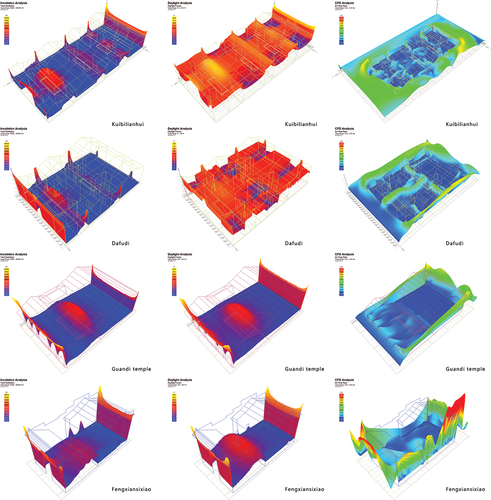
Table 4. Material parameter list.
Table 5. Value of roof constant load.
Table 6. Nodal load table.
Besides, there are many semi-rigid joints and rods in the building system, and it is too difficult and unrealistic to analyze one by one. Moreover, these small components mainly contribute to the overall performance of the structure rather than important stress components, and local deterioration will not have much impact. Therefore, this study focuses on the stress and deformation of column joints of different frame types under their respective load conditions, without considering the influence of the stiffness change of roof system.
As for the horizontal load and live load, in traditional buildings, the wind load is mainly borne by the thick brick walls wrapped around the building. However, this study mainly discusses the mechanical properties of different types of wood structures under their own conditions. Therefore, the above two do not do excessive in-depth discussion.
In the displacement part, the max displacement of stigma in tailiang style is 0.132 m. In chuandou type, the max displacement of stigma is 0.181 m. The max displacement node mainly appears on the stigma, and the main displacement node appears on the column or the intersection of column and fang, which is consistent with the load-bearing of wood frame mainly composed of column head node and column fang node ().
Table 7. Stress distribution diagram and displacement distribution diagram (Source: self drawn by the author).
In the stress distribution diagram, the stress concentration parts of the tailiang type are the front jinzhu and the rear jinzhu, with the stress value of 0.277 MPa, the front and rear yanzhu are slightly lower, with the value of 0.162 MPa. In chuandou type, the stress is also mainly distributed on the front and rear jinzhu (max for 0.390 MPa), followed by the front and rear dongzhu (max for 0.309MGPa) yanzhu and the yanzhu (max for 0.167Mpa) ().
It can be seen that the width of tailiang is usually smaller than that of chuandou in order to weaken the influence caused by the cancellation of the central column, so the load of the column head of tailiang is smaller than that of chuandou (). Therefore, in practical application, they are often combined to give full use to their respective advantages.
Besides, ancestral temples and god temples using tailiang are often smaller in scale, while dwellings and ancestral temple using chuandou can be larger in scale. Therefor, ancestral temple and god temples with no use of residence often use tailiang. Dwellings focusing on residential functions often use chuandou. Dwellings and ancestral temples that need both residence and sacrifice are often used in combination with tailiang and chuandou. This reflects the relationship between frame type and building function.
In tailiang style, in order to get more interior space and reduce the practice of building column, make overall stress concentration in the front and rear jinzhu, therefore, in the tailiang timber frame construction, front and rear jinzhu usually take amplification processing, through increasing section area, or in connection with chuandou timber frame combination methods to improve the stress distribution of the building. Compared with the tailiang type, the stress distribution in the chuandou type frame is more uniform, and the material properties of each column are fully utilized.
5. Simulation analysis of light environment and wind environment
The daylight lighting simulation analysis based on Ecotect shows that different building types need to adjust the architectural form for the use of functions. The daylighting analysis and thermal analysis are realized after importing the local meteorological data of Fuzhou (Yiqian is located in Fuzhou city) into Ecotect and analyzing the dynamic model 1:1 modeling with the original building. In both simulations, the building models were placed in a north-south orientation.
Light environment simulation is not date or time dependent; they represent worst-case design conditions based on an “average” cloudy or uniform sky distribution in mid-winter. Calculations are based on the BRE Split Flux Method which uses daylight factors and the design sky illuminance value to determine likely natural light levels in the model.
The dwellings represented by kuibilianhui and dafudi always set multiple courtyards and side doors on both sides of the hall to enhance the lighting, and lighting windows are often added on the building facade. The peak value of indoor light radiation in dafudi is 63000 Wh, and the peak value of annual lighting rate is 80%, and the distribution is very uniform, and the lighting scope almost covers the whole house. The indoor light radiation peak of kuibilianhui is 576000Wh, and the annual peak lighting rate is 80%. The distribution is similar to that of dafudi House (Figure 12).
Ancestral temple architecture is different from dwellings, in addition, there are no side doors on both sides of the courtyard, and the lighting mainly relies on the central courtyard and the main entrance. Meanwhile, the higher eaves slow down the scattering of sunlight to the main room, which is closely related to the aforementioned characteristics that ancestral buildings are not for people to live in. Fengxiansixiao’s indoor peak light radiation is 360000 Wh, indoor annual peak lighting rate is 72% (Figure 12).
God temple building represented by Guandi temple is more open, with a peak indoor light radiation of 544500Wh and a peak indoor annual lighting rate of 68%. The reason why temples are higher than ancestral halls and lower than residential buildings is that god temples are public buildings and open to the community, so they have multiple doors or are completely open without doors. In contrast, ancestral halls and residential buildings are mainly open to family members. The privacy requirements of the former and the residential requirements of the latter contribute to the emergence of this phenomenon (Figure 12).
The wind environment simulation is based on win Air plug-in, and the wind speed is set at 5 m/s (can blow the flag) under the local dominant wind direction in summer. The material of wall is set as green brick and the roof as green tile.
The wind analysis shows that it is one of the manifestations of the demand on the architectural form. Although there are courtyards in fengxiansixao and guandi temple, the closed courtyard wall weakens the ventilation function of the courtyards, and the long front hall lengthens the path through the air exchange at the front door. Therefore, it can be seen that in this kind of building, the courtyards mainly play the role of lighting (Figure 12).
Courtyard in the residence buildings are different, the effect of transverse parallel central atrium and longitudinal wing series, side courtyard is made up of a complex and efficient ventilation network, compared with the ancestral temple, god temple, residential courtyard has markedly increased, the number of narrow front hallway depth and between various hall also can through the side door, wing courtyard system to enhance air flow guidance.
6. Conclusion
This paper introduces the types of traditional buildings in Yiqian town with their common plane types and frame types. Furthermore, 13 typical representatives of 43 traditional buildings were selected to draw their plane features and simulate the sunshine and wind environment with Ecotect software. The data of the frame of these buildings were statistically analyzed by ABAQUS software, and the following conclusions were drawn.
(1) Highly applicable plane mode
Courtyard style and tanghengtwu style are typical representatives of traditional dwellings in Yiqian. By using different combinations of multiple courtyards and halls, the craftsmen of Yiqian create a plane model with high applicability. It is applied in dwellings, ancestral temples and god temples. For different building types and functions, it can be used only by slightly adjusting or adding plane components. It can be called the initial application of ancient modular design in traditional architecture. It is the result of the balance of many factors such as function and form, and reflects the pursuit and exploration of rationality by ancient Chinese craftsmen.
(2) Flexible wood frame processing technology
The wooden frame in Yiqian showing a more mixed performance in the types and flexible in using.
In dwellings, the Chuandou type is the majority. Zhengtie with tailiang and biantie with Chuandou type are also used. In ancestral temple, chuandou, tailiang and Combination of chuandou & tailiang type are all used. The god temples are all pure Tailiang. For different functions, different types of traditional buildings, flexible use of a variety of structural forms to give full play to the advantages of different structural forms.
Abaqus’ simulation and analysis of the mechanical characteristics of wooden frame is also an effective response. In a word, the Timber frame of traditional architecture in Yiqian Town presents a situation of simultaneous development of Tailiang and Chuandou and the hybrid, thus developing a unique characteristic mixed wooden frame system.
(3) Climate adapted architectural form
By analyzing the simulation results of the Ecotect software light environment and wind environment of the traditional buildings in Yiqian Town, we were able to explore the influence of structural form, building type and plane type on the light and thermal environment of traditional buildings.
Thick blue bricks are conducive to adjusting the indoor temperature difference between day and night, blocking the high intensity of outdoor heat radiation into the room during the day, providing indoor heat preservation at night, and the setting of the patio can form a low-temperature zone indoors. Using indoor and outdoor temperature field to form positive pressure ventilation to achieve all-weather natural ventilation passive ventilation strategy. Suitable eaves height can effectively block the summer sunlight radiation, and the existence of the patio makes the good lighting conditions between the hall to achieve.
By choosing the appropriate structural form and plane type, people can easily obtain buildings that are suitable for the environment and corresponding to the functional requirements of the corresponding building type. These traditional ecological technologies contain rich traditional Chinese technology and culture and have important reference significance for contemporary architectural design.
Disclosure statement
No potential conflict of interest was reported by the author(s).
Additional information
Funding
Notes on contributors
Ziming Zhao
Ziming Zhao Master Degree Candidate, Architecture & Design College of Nanchang University, Nan Chang, China; Jiangxi Cultural Heritage Protection Center, Nan Chang, China.
Kai Ma
Kai Ma Associate Professor, Architecture & Design College of Nanchang University, Nan Chang, China.
Tang Yao
Tang Yao Professor, Architecture & Design College of Nanchang University, Nan Chang, China.
References
- Hu, X. 2018. Study on the Mechanical Properties and Evaluation Method of Traditional Wooden Structure in Southeast. Guizhou: South China University of Technology.
- Huang, H. 2008. Jiangxi Dwellings. Beijing: China Architecture & Building Press.
- Ji, C., and T. Ni. 2017. Yuanye. Chongqing: Chongqing Publishing House.
- Li, T., and X. J. Xiao. 2008. “Cultural Exploration of Carved Decorations in Ancient Buildings of Ming and Qing Dynasties in Yiqian.” Jiangxi Social Sciences 10: 244–246.
- Yao, T., and Q. Cai. 2016. Ancient Buildings of Jiangxi. Beijing: China Architecture & Building Press.

